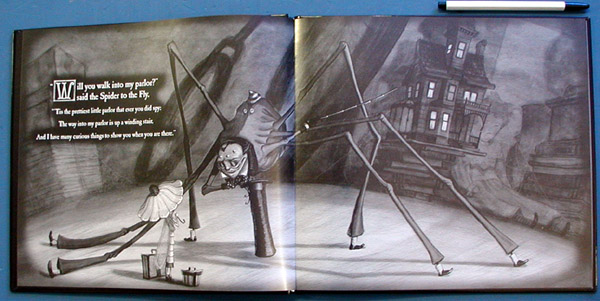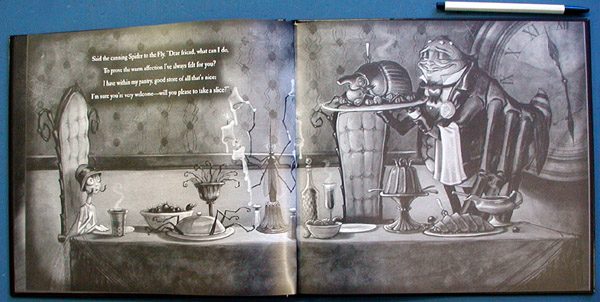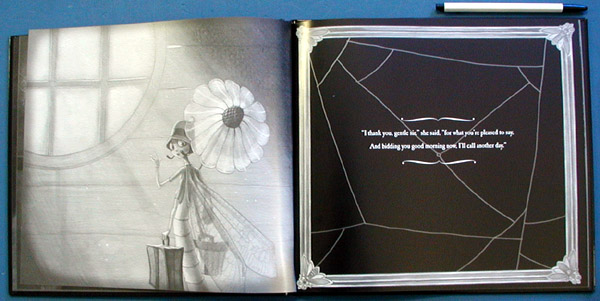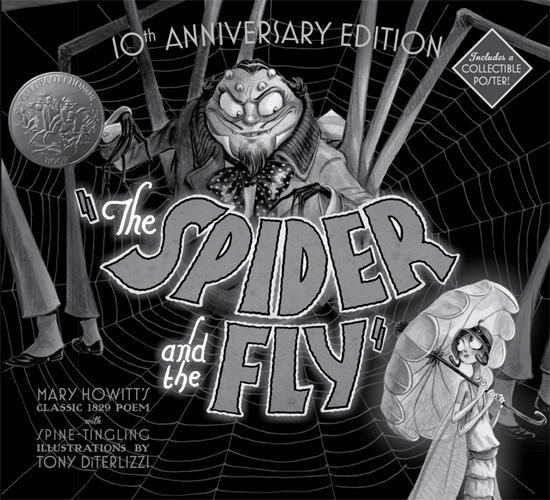|
|
|
|
 |
 이전 | 이전 |  목록 | 다음 목록 | 다음 |
|
|

상세그림 1 |

상세그림 2 |

상세그림 3 |

표지확대 |
|
확대 이미지 : 상세그림 1

|
확대 이미지 : 상세그림 2

|
확대 이미지 : 상세그림 3

|
확대 이미지 : 표지확대

|
[ 책 소개 ]
* Caldecott Honor 수상작
* ALA Notable Children's Books
* Beehive Award Master List
* CCBC Choices (Cooperative Children's Book Council)
* Charlotte Award Ballot
* Great Lakes Great Books Master List
* IRA/CBC Children's Choices Louisiana Young Readers' Choice Master List
* Zena Sutherland Award (University of Chicago Laboratory Schools)
영국 시인 Mary Howitt가 1829년에 쓴 시를 저명한 Artist인 Tony DiTerlizzi가 아름다운 흑백의 그림으로 재구성했습니다.
예쁜 잠자리가 음흉한 거미의 아첨과 꾐에 빠져 결국 먹이가 되고 만다는 내용이며, 듣기 좋은 달콤한 말을 하는 사람들을 경계해야 한다는 교훈을 깨닫게 해줍니다.
Tony Diterlizzi의 그림은 20세기 초반의 흑백 무성영화의 분위기를 살리고 있으며, 어두움 속에서 은빛으로 빛나는듯한 그림은 흑백의 단순한 색상만을 사용했음에도 오히려 화려하게 느껴집니다.
출간 10주년을 기념해서 만든 Large Size의 튼튼한 하드커버입니다. 더스트커버는 뒷면에 멋진 그림이 인쇄되어 있어서 포스터로 사용할 수 있습니다.
[ 서지 정보 ]
Edition: Hardcover: 40 pages
ISBN-10: 1442454547
ISBN-13: 978-1442454545
책 크기 : 28.5cm x 26cm
[ 영문 서평 ]
Book Description
A special 10th Anniversary Edition of an illustrated classic that won the Caldecott Honor. Includes a collectible poster showcasing original art.
"'Will you walk into my parlor,said the Spider to the Fly..." is easily one of the most recognized and quoted first lines in all of English verse. But do you have any idea how the age-old tale of the Spider and the Fly ends? Join celebrated artist Tony DiTerlizzi as he -- drawing inspiration from one of his loves, the classic Hollywood horror movies of the 1920s and 1930s -- shines a cinematic spotlight on Mary Howitt's warning, written to her own children about those who use sweet words to hide their not-so-sweet intentions.
From the Publisher
An illustrated version of the well-known poem about a wily spider who preys on the vanity and innocence of a little fly.
Publisher's Weekly
Howitt's 1829 cautionary poem of a fly's risky entanglement with her perfidious predator springs to cinematic life amid silver-sheened black-and-white illustrations by an artist well known for his work on the Magic: The Gathering trading cards. Gouache images that seem to glow in the dark deftly recall the silent film era, craftily luring in readers even before the tale's famous opener, " `Will you walk into my parlor?' said the Spider to the Fly." An exterior view of a darkened mansion, its sole light coming from an attic window, gives way to a close-up of the same window as a petite dragonfly in flapper attire (complete with fringed dress, long gloves and flower-petal parasol) peers inside at Spider's lair: a Victorian dollhouse set amid cobwebby attic treasures. With an arsenal of Vincent Price expressions, the well-heeled Spider uses food and flattery to entice his guest into staying within his walls. Some of the text appears periodically against a framed black backdrop, la silent movie captions, while a silvery web is progressively woven in the background. Finely detailed scenes foreshadow Fly's demise with subtle, Charles Addams-esque humor that, while it may escape younger readers, will tickle the Lemony Snicket set. (In one scene, previous insect victims, now ghosts with their feet hovering above the floor, hold up a copy of The Joy of Cooking Bugs, in a vain warning to Fly.) DiTerlizzi has spun a visual treat that young sophisticates and adults alike will enjoy.
Children's Literature
The poem is more than 150 years old, but the message to children that "not everyone who talks sweetly offers sweets" is sadly truer than ever. The message in this new edition is told with spooky fun dramatized by Tony DiTerlizzi's silly but imaginative drawings, all in shades of black, white and gray. Youngsters might wonder about a picture book with no color, but black is indeed the color of Halloween. There are marvelous details to point out to children, such as the looking glass that is really a bottle cap, the curtains that are butterfly wings or the various delicacies spread out on the spider's dining room table. The 19th century language of the original poem will necessitate explanations of such phrases as "give heed" and "unto an evil counselor," but the book will be marvelous for a simple storytime and not exclusively at Halloween or a reading animated by discussion of either the message or the artwork.
School Library Journal
This illustrated version of the old poem clearly states the ``beware of strangers'' message. The rather lengthy poem describes the many ways in which the spider attempts to woo the fly into his web. The feminine fly repeatedly refuses the spider's flattery, but finally succumbs and meets her fate. The message of the poem is pointedly clear. Yet this book also offers an addendum, which parodies the main poem and presents a modern day example of why it is best not to trust strangers; it is moralistic, didactic, and unnecessary. The illustrations, too, leave much to be desired. The anthropomorphic drawings of spider and fly are unattractive and may be frightening to some children. As for the ``stranger danger'' message, the poem itself, sans these illustrations and addendum, would be a good supplement to books such as Dorothy Chlad's Strangers (Childrens, 1982) or Stan and Jan Berenstein's The Berenstein Bears Learn About Strangers (Random, 1985), each of which provides practical information about strangers and how to deal with them.
Kirkus Starred Review
"'Will you walk into my parlor?'/said the Spider to the Fly." Howitt's 1829 cautionary poem is realized here in full cinematic fashion. Delightfully ghoulish full-bleed black-and-white spreads are rendered in gouache and pencil, and reproduced in silver-and-black duotone, resulting in images that recall the slightly fuzzy-edged figures from old black-and-white horror movies. The typeface and occasional framed text pages heighten this effect by evoking silent-movie titles. The setting is a dustily gothic attic in which DiTerlizzi's (Alien and Possum: Friends No Matter What, ) "camera" never rests, zooming in, out, up, and down in a dazzling series of perspectives as a top-hatted and bespatted spider romances a na?e flapper fly. Her protestations in the face of his overtures grow ever weaker, and despite the warnings of the ghostly figures of past victims (one brandishes a knife and fork while another points urgently at The Joy of Cooking Bugs), she goes to her inevitable doom. The illustrations embrace the primness of the poem -- the wide-eyed fly is the very picture of a bygone innocence -- but introduce a wealth of detail that adds a thick layer of humor. Aside from the aforementioned ghosts, evidence of the spider's predilections abounds: in his parlor, he relaxes with his feet up on a very dead ladybug stool with X's for eyes. A tongue-in-cheek "letter" from the spider follows the poem, in which he exhorts readers to "be advised that spiders are not the only hunters and bugs are not the only victims." This cautionary intrusion serves to explicate the metaphor for concretely minded readers, but the message is not likely to diminish their pleasure in the grisly doings one bit.
Booklist
There's no question about the villain in this version of Howitt's familiar 1829 poem about the vain, silly fly and the cunning spider who does her in. The smarmy visage of the spider leering at Miss Fly, who is sweetly attired in fringed flapper garb, says plenty. The melodrama is wonderful: Miss Fly--hand on forehead, hand on heart, two hands outstretched in protest (and two legs, of course, makes six)--declares, "Oh no, no . . . Kind sir, that cannot be. / I've heard what's in your pantry and I do not wish to see." Diaphanous ghosts of Spider's previous victims float nearby, but they're unable to change the fate of Miss Fly, who falls victim to Spider's flattery and her own pleasing reflection in a bottle-cap looking glass. Older children will be most likely to catch the intricacies in the monochromatic artwork--the various poses of the multiple appendages, the butterfly-wing curtains, and other delightfully creepy buggy details. Only a few will think past the story and wonder about the fact that most spiders are female.
|
| * 최근 이 작품을 구입하신 분들의 다른 선택 |
The Goose Egg
하드커버, 슈퍼바이 |
Miss Rumphius
American Book Award 수상도서, 페이퍼백, 슈퍼바이 |
The Mother's Day Mice
Jan Brett 그림책, 하드커버 Gift 에디션, 슈퍼바이 |
Sophie's Masterpiece: A Spider's Tale
페이퍼백, 슈퍼바이 |
|
| |
|
|< << [1] [2] [3] [4] [5] [6] [7] [8] [9] [10] >> >|
|
|
|